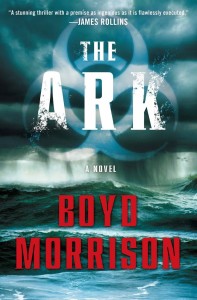Boyd Morrison does not know what he wants to be when he grows up. So along the way in his life’s trek he got himself a PhD in industrial engineering, worked on the Space Station Freedom project at Johnson Space Center, got some really tough duty managing an Xbox games group at Microsoft, was and still is a professional actor . . . and, oh yeah, made a little stop on TV to became a Jeopardy champion.
One other little item: he’s got a hot new novel that just came out from Simon & Schuster. It’s called The Ark.
Boyd’s journey to publication covers about 13 years, and I wanted to interview him for TKZ because I saw someone who approached this whole business wisely and systematically. In this interview, along with everything else, you’ll find Boyd’s tips about getting the most from a conference. Pure gold. Be sure to learn more about Boyd at his website, BoydMorrison.com. 
JSB: Publication of your novel, The Ark, is a success story with a unique background. How did you get the idea?
BM: Engineers usually get a raw deal in thriller fiction, which is something I pay attention to because I’m an engineer myself. When the strapping hero needs some critical piece of technology to save the world, he turns to an engineer for said object or solution and then proceeds to kick butt (think James Bond getting his gadgets from Q or Captain Kirk demanding more power from Scotty). And I got sick of that, so I decided to cut out the middleman and create an action hero named Tyler Locke who IS an engineer. Nerds rule!
While I was looking for an adventure for Tyler to swashbuckle through, I saw a documentary on the search for Noah’s Ark. I’m a skeptic by nature, so my first thought was, “Yeah right. They’re going to find a 6,000-year-old ship intact on a snowy mountaintop.” But then I got the inkling of an idea: maybe the reason we’ve never found Noah’s Ark was because we had been deceived all these years as to its true location. And maybe the Ark held such a terrible secret that it could very well mean the end of mankind if it were ever found again. Noah was the first engineer (who else but an engineer could build the Ark?), so it was the perfect object for Tyler to search for.
JSB: How did you get an agent to represent The Ark?
BM: The Ark was the third book I wrote, so I had already gone through two rounds of rejections from agents (both of those books have since been acquired by Simon & Schuster). But I had gotten pretty good at pitching my novels, and I’m a big believer in meeting agents in person. It’s so much easier to get your first three chapters read by an agent when you can put “Requested Materials” on the envelope. So I attended the very first Agentfest at the Thrillerfest conference in 2007.
Today Agentfest is done speed-dating style, but the first Agentfest was more leisurely paced, with an agent sitting at each of the tables during the luncheon session. I was late to the luncheon, so I snagged a seat at the very last table. Irene Goodman, who is a highly regarded agent, was attending because she was looking at extending her client list to include thriller authors. She asked every aspiring author at the table to give her their pitch. I had practiced mine so that I could rattle it off. It went like this:
“A relic from Noah’s Ark gives a religious fanatic and his followers a weapon that will let them recreate the effects of the biblical flood, and former combat engineer Tyler Locke has seven days to find the Ark and the secret hidden inside before it’s used to wipe out civilization again.”
I could have stopped at the words “Noah’s Ark” because once she heard them she asked to read the first three chapters. I was still working on my own revisions, so it took a couple of months before it was ready to send to her. She told me later that she started to wonder if I’d forgotten about her, but she was one of the first agents I sent it to (I sent it to my five highest agent choices as a simultaneous submission).
She got the chapters on a Monday, read them right away, and then called me when she was done. That day. I practically keeled over in my chair when I got the phone call because no agent had ever called me before. She said she loved the beginning and asked me if I would mind overnighting the rest of the manuscript (note to aspiring authors: it’s a good sign when the agent is that eager to get the manuscript). I told her I’d have to think about…oh, who am I kidding? I was already in the car on the way to the post office before she had finished her question.
Irene received the manuscript on a Tuesday, and I figured it would be at least a week before she got back to me. She called on Thursday. With an offer of representation. This time, I did keel over. But I pulled it together and told her I would have to contact the other agents who had it before I could give her an answer. After a few frantic phone calls to the other agents who had the submission, I called Irene back on Friday and said I would love for her to be my agent.
Again, all of this was in 2007. So for those of you who think getting an agent means a smooth path to publication, I’d like to remind you that it’s now 2010. The book that Irene snapped up in five days took three years to get published.
JSB: You have been very good not only about attending the top conferences, but getting the most out of them by meeting people, networking and so on. What tips can you give unpublished writers in this regard?
BM: Virtually every person I know in the writing and publishing industry I met at conferences, so I highly recommend that unpublished writers attend them. I could write twenty pages on writers conferences, but I’ll boil it down to a few key points.
Know why you’re going
Attending a conference is well worth the time and money when you know what you want to get out of it. If you want to meet agents, going to a conference like Bouchercon or Left Coast Crime will be a waste of time because few agents attend them, and then it’s usually to serve on a panel, not to search for prospective clients. But if you want to meet writers and readers, Bcon and LCC are perfect. There are plenty of conferences featuring agents looking for new clients. Check out the back of Writer’s Digest magazine for conferences near you.
Don’t be afraid
Everyone I’ve met at conferences was incredibly welcoming to me when I was unpublished. No one looks down on unpublished authors. In fact, they’re very encouraging. So go up to people and introduce yourself. You’ll probably make many friends, as I have. It doesn’t matter if they’re writers, agents, editors, or readers. Everybody there wants to meet other people. And one important tip: agents and writers hang out at the hotel bar at night; having a drink with them (or even buying a round) is a great way to hear the best industry stories.
Have your pitch ready
If you’re pitching a novel, it needs to be a completed manuscript. Nothing disappoints an agent more to hear the idea for a great novel and then find out it won’t be done for another year. Have your novel boiled down to a sentence or two that outlines the premise for the plot and the main character that the reader will be rooting for. Then you can elaborate if and when the agent asks follow-up questions. Memorize the pitch so that you can say it without thinking. If you ramble about your story for five minutes, you’re going to confuse agents and make them think your manuscript will be just as rambling.
Be nice
This last point should go without saying, but it needs to be emphasized. Be friendly and polite. Smile. You can introduce yourself to agents even if they’re not in a pitch session, but don’t follow them into a bathroom or slide your manuscript under a stall (believe or not, this happens). Don’t put writers on the spot by asking for blurbs in person. If you get to know them, follow-up later with an email asking if they have time to read your manuscript (don’t be offended or take it personally if they don’t; published writers are super busy as I’ve recently discovered first hand).
Have fun
Writing is a solitary business, so enjoy yourself in the supportive community of a conference. Every writer gets their batteries recharged by hearing from other writers who’ve been through exactly what they’re going through and made it as a published author. Those conference memories help keep you going when you’re sitting by yourself in front of that white screen.
JSB: Tell us a little about your acting self (that makes about three or four “selves” I count for you).
BM: My acting hobby is the exact opposite of my day job as a writer. Writing is rewarding and fun, but it is not interactive or, for that matter, active. Acting–well, it’s right there in the word–gets me up on my feet in a collaborative environment with a lot of other talented people. And it’s a blast–I mean, they are called “plays” after all. For some reason, I have a need to perform, usually at great peril of making an idiot of myself. I’ve done stand-up comedy, musicals, improv, stage productions, commercials, and films. I’ve even done some print ads, and I appeared on the packaging for an herbal tea while wearing a space helmet (you think I’m joking, but I’m not).
Plays are my favorite. There’s nothing better than getting that audience reaction when you make them laugh or cry or gasp in surprise. For me, comedies are the most fun. I’ve done some of the classics, including Noises Off, The Importance of Being Earnest, and Barefoot in the Park. Last year, I appeared in Leading Ladies, a Tootsie-style play featuring yours truly trying to pass himself off as a woman to get an inheritance. And I just finished a five-week run in Rumors by Neil Simon, a farce in which I played a politician who keeps putting his foot in his mouth.
JSB: Boyd, many thanks for giving us the time and benefit of your experience getting to publication.









